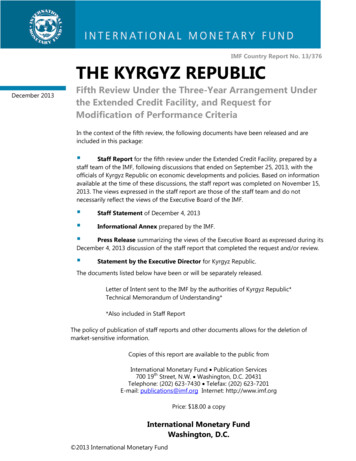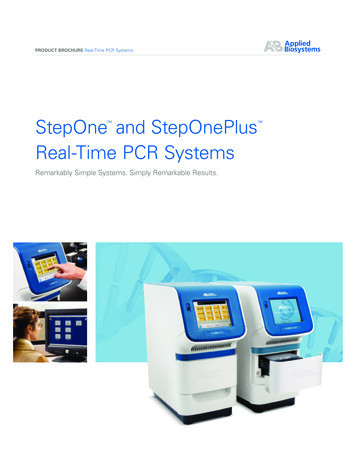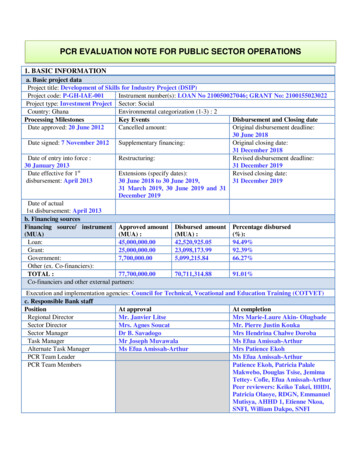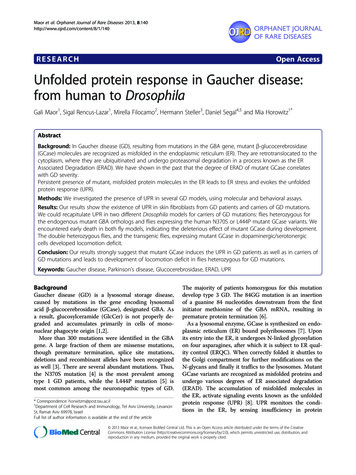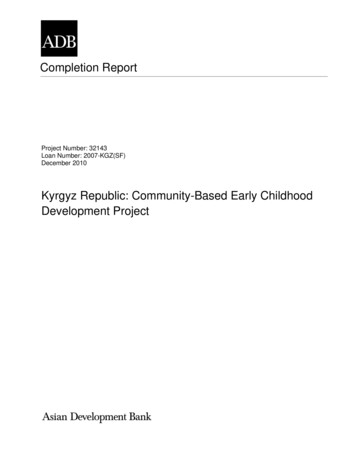
Transcription
Completion ReportProject Number: 32143Loan Number: 2007-KGZ(SF)December 2010Kyrgyz Republic: Community-Based Early ChildhoodDevelopment Project
CURRENCY EQUIVALENTSCurrency UnitSom1.00 1.00 –At Appraisal5 August 2003 0.0247Som40.4850som (Som)At Project Completion31 March 2010 �–––––––––––Asian Development Bankadditional drug packagechild and family coordinatorDemographic and Health SurveyDesign and Monitoring Frameworkearly childhood developmenteconomic internal rate of returnExtended Program of ImmunizationFamily Group Practiceformer Soviet Unioniron deficiency anemiaiodine deficiency disorderinformation, education, and communicationIntegrated Management of Childhood Illnessesinfant mortality rateMillennium Development GoalMandatory Health Insurance FundMinistry of Labor and Social ProtectionMinistry of Education and CultureMinistry of Education and ScienceMinistry of FinanceMinistry of Healthnongovernment organizationproject coordination officeproject management officespecial drawing rightstechnical assistanceunder-five mortality rateUnited Nations Children’s FundUnited States Agency for International DevelopmentVillage Initiative FundWorld Health Organization
GLOSSARYayil okmotu (AO)accoucheur(midwife) posts(FAP)feldsheroblastraion––village authorityprimary health care post–––primary health care workerprovincedistrictNOTES(i)The fiscal year (FY) of the Government of the Kyrgyz Republic and its agenciesends on 31 December.(ii)In this report, " " refers to US dollars.Vice-PresidentDirector GeneralCountry DirectorSector DirectorX. Zhao, Operations 1J. Miranda, Central and West Asia Department (CWRD)L. Wu, Kyrgyz Resident Mission (KYRM), CWRDD. Kertzman, Financial Sector, Public Management and Trade Division,CWRDTeam leaderTeam membersA. Chyngysheva, Portfolio Management Specialist, CWRDG. Tentieva, Economics Officer, CWRDR. Hiraoka, Principal Portfolio Management Specialist, Office of theDirector General, Southeast Asia DepartmentA. Imanova, Assistant Project Analyst, CWRDIn preparing any country program or strategy, financing any project, or by making anydesignation of or reference to a particular territory or geographic area in this document, theAsian Development Bank does not intend to make any judgments as to the legal or other statusof any territory or area.
CONTENTSPageBASIC DATAiMAPviI.PROJECT DESCRIPTION1II.EVALUATION OF DESIGN AND 9III.IV.Relevance of Design and FormulationProject OutputsProject CostsDisbursementsProject ScheduleImplementation ArrangementsConditions and CovenantsRelated Technical AssistanceConsultant Recruitment and ProcurementPerformance of Consultants, Contractors, and SuppliersPerformance of the Borrower and the Executing AgencyPerformance of the Asian Development BankEVALUATION OF eness in Achieving the OutcomeEfficiency in Achieving Outcome and OutputsPreliminary Assessment of SustainabilityImpactOVERALL ASSESSMENT AND RECOMMENDATIONS14A.B.C.141415Overall 5.6.7.8.9.10.11.12.13.Project FrameworkVaccine Procurement FinancingPublic–Private Partnership for Sustainable Drug SupplyPublic Awareness of Iodine Deficiency Disorder and Iodine Deficiency AnemiaEstablishment of Community-based PreschoolsMajor Regulations and Guidelines, Training Materials, and Modules to Support ChildCare and Education ComponentVillage Initiative FundComparison of Appraisal and Actual Project CostYearly Disbursement of Loan ProceedsStatus of Compliance with Loan CovenantsExtended Program for Immunization CoveragePercentage of Children Entering Primary School after Preschool ProgramsInfant Mortality Rate16212224252627282930363839
BASIC DATAA.B.Loan Identification1.2.3.CountryLoan NumberProject Title4.5.6.7.BorrowerExecuting AgencyAmount of LoanProject Completion Report NumberLoan Data1.Appraisal– Date Started– Date Completed2.The Kyrgyz Republic2007-KGZ(SF)Community-Based Early Childhood DevelopmentProjectThe Kyrgyz RepublicPresident’s Office of the Kyrgyz RepublicSDR7,545,000PCR: KGZ 12166 June 200318 June 2003Loan Negotiations– Date Started– Date Completed21 August 200322 August 20033.Date of Board Approval29 September 20034.Date of Loan Agreement14 January 20045.Date of Loan Effectiveness– In Loan Agreement– Actual– Number of Extensions14 April 200410 March 2004NoClosing Date– In Loan Agreement– Actual– Number of Extensions30 June 200931 March 201016.7.Terms of Loan– Interest Rate– Maturity (number of years)– Grace Period (number of years)8.Terms of Relending (if any)– Interest Rate– Maturity (number of years)– Grace Period (number of years)– Second-Step Borrower1% per annum during the grace period and1.5% per annum thereafter328
ii9.Disbursementsa.DatesInitial DisbursementFinal DisbursementTime Interval28 April 20041 June 201073 monthsEffective DateOriginal Closing DateTime Interval10 March 200430 June 200963 monthsb.Category orSubloanOriginalAllocationAmount ntAvailableAmountDisbursedUndisbursedBalance1. Civil Works588,000521,50044,118477,382477,38202A. Furniture481,000550,000152,535397,465397,46502B. 0001,728,000188,8831,539,1171,539,11703. Training429,000766,500358,585407,915407,91504. Community andInformation,Education, 56,50105. Village ,62809. 09010. 097,000165,000165,0000007,545,0007,545,000* Latest date of category reallocation: 20 March 2009** Amount at the loan closing stage: 2 June 2010.1,606,5885,938,4125,938,41202C. Supplies6. Surveys7. ConsultingServices8. Monitoring andData Acquisition11. UnallocatedTotal
iiib.Category orSubloanAmount ( dBalance1. Civil Works819,000790,21465,044701,549701,54902A. Furniture670,000833,399224,887610,098610,09802B. 0002,618,388278,4762,336,1492,336,14903. Training597,0001,161,455528,673617,403617,40304. Community andInformation,Education, 786,44705. Village 8,62609. 91010. 526,000250,020243,2640002C. Supplies6. Surveys7. ConsultingServices8. Monitoring andData Acquisition11. ,0829,058,0820* Amount in US dollars represents the actual dollar equivalent of the special drawing rights at the date of the latestcategory reallocation: 20 March 2009.** Amount in US dollars represents the actual dollar equivalent of the special drawing rights at the loan closing stage: 2June 2010.10.C.Local Costs (Financed)- Amount ( )- Percent of Local Costs- Percent of Total Cost2,574,15946.6828.42Project Data1.Project Cost ( ’000)CostForeign Exchange CostLocal Currency CostTotalAppraisal Estimate5,3838,08713,470Actual6,4843,77610,260
iv2.Financing Plan ( ’000)CostImplementation CostsBorrower FinancedADB FinancedOther External Financing (Communities)TotalIDC CostsBorrower FinancedADB FinancedOther External FinancingTotalAppraisal 000226013,47000245010,260ADB Asian Development Bank, IDC interest during construction.3.Cost Breakdown by Project Component ( ’000)ComponentChild Health and NutritionEarly Childhood Care and EducationCapacity BuildingProject Management SupportTaxes and DutiesSubtotalContingenciesInterest ChargesTotal4.Appraisal ject ScheduleItemDate of Contract with ConsultantsCivil Works ContractDate of AwardCompletion of WorkEquipment and SuppliesFirst ProcurementLast ProcurementCompletion of Equipment InstallationAppraisal Estimate4Q 2003Actual3Q 20042Q 20043Q 20053Q 20043Q 20051Q 20041Q 20083Q 20082Q 20044Q 20091Q 2010Q quarter.5.Project Performance Report RatingsRatingsImplementation PeriodFrom 29 September 2003 to 30 October 2008From 1 November 2008 to 31 March 2010HS highly successful, S ressSSHSS
vD.Data on Asian Development Bank MissionsName of eviewReviewReviewProject CompletionReviewDate10–28 February 20036–18 June 20032–12 December 200321–30 April 20046–17 September 200411–16 November 200410–23 March 200516–25 November 200525 January–6 February 200618–28 September 20065–16 February 200718–25 September 20076–14 November 20088–14 April 200910–17 September 200923 March–10 April 2010No. ofPersons4343212223122233No. tionof Membersa, b, c, da, c, ea, c, f, ga, c, fa, caaa, ca, ca, c, haa, ia, ga, ga, c, ga, c, ha social protection specialist, b young professional, c project implementation officer, d implementation andmanagement specialist/consultant, e senior counsel, f project specialist, g project analyst, h assistantproject analyst, i community-driven specialist/ consultant.
o78 00'E71o 00'EKYRGYZ REPUBLICCOMMUNITY--BASED EARLY CHILDHOODDEVELOPMENT PROJECT(as completed)KAZAK H STANTyupDzhergalano42 30'NBISHKEKShopokovKantNovopavlovkaKaraKayingdy BaltaKeminCholpon-AtaTokmokBalykchyIssLakeo42 chkorBakay AtaISSYK-KULTALASSuusamyrChaekLake Song-KulToktogulKanyshKiyaNARYNToktogul BADArslanbobShamaldySaiKochkor AtaBazar-KorgonKazarmanJalal-AbadAndizhan ReservoirUzgenKara rynNLake l KiyaTAJIKISTANNaimanChauvayo38 00'NNational CapitalIrkeshtamHaidarkanSulyuktaOSHProject AreaFrunzeBatkenSary TashBATKENProvincial CapitalPEOPLE'S REPUBLICOF CHINACity/TownMain RoadOther RoadDaroot-KorgonRailwayRiverTAJIKISTAN10-2616 HRThis map was produced by the cartography unit of the Asian Development Bank.The boundaries, colors, denominations, and any other information shown on thismap do not imply, on the part of the Asian Development Bank, any judgment on thelegal status of any territory, or any endorsement or acceptance of such boundaries,colors, denominations, or information.71o 00'EDistrict BoundaryProvincial BoundaryInternational BoundaryBoundaries are not necessarily authoritative.o78 00'Eo38 00'N
I.PROJECT DESCRIPTION1.Early childhood development (ECD) refers to the physical and psychosocial developmentthat takes place in the first several years of life. Evidence is growing that ECD has long-lastingeffects and is critical to human development. Before the collapse of the former Soviet Union in1991, young children in the Kyrgyz Republic received a comprehensive package of ECD services,comprising child health care, nutrition, and nursery and/or preschool programs. Pregnant womenhad access to antenatal care that helped maintain maternal health and mitigated risks associatedwith pregnancy. Poverty was far less prevalent than it is today. The favorable ECD situationchanged dramatically in the decade after 1991, with ECD deteriorating largely as a consequenceof economic contraction, increased poverty, and decline in social services. Child health andnutrition worsened, a large number of preschool institutions were closed down, and parents wereleft without sufficient resources or knowledge to care for children at home. The decline of ECDrelated services had a negative impact on the general development potential of children in thecountry. Achieving the Millennium Development Goals (MDGs) by 2015 became unlikely, withmajor efforts required to meet the targets of reducing the infant mortality rate (IMR) and under-fivemortality rate (U5MR) and sustaining universal primary education by arresting the problem ofincreasing dropouts.2.Recognizing the importance of child development, the Government of the Kyrgyz Republicasked Asian Development Bank (ADB) to finance the Community-Based Early ChildhoodDevelopment Project. The aim of the project, approved in 2003, was to enhance the developmentof young children between birth and 8 years of age by providing holistic interventions to improvehealth, nutrition, and psychosocial development.1 The performance indicators were to (i) reducethe IMR, reduce U5MR, (iii) reduce the incidences of iodine deficiency disorder (IDD), (iv) reducethe prevalence of iron deficiency anemia (IDA) both among children and pregnant women, and (v)improve the psychosocial development of preschool children. The project was composed of threecomponents: (i) child health and nutrition, (ii) early childhood care and education, and (iii) capacitybuilding. The project was to focus on the 12 poorest raions (districts) in Jalal-Abad, Naryn, andOsh oblasts (provinces),2 while ensuring that the extended program of immunization would coverthe needs of all eligible children in the country. Technical assistance (TA) was also provided toimprove the government’s capacity for pursuing an effective ECD program. To ensure strongleadership and effective implementation through multiple ministries and central and localgovernment bodies, the president’s office was selected as the executing agency.II.A.EVALUATION OF DESIGN AND IMPLEMENTATIONRelevance of Design and Formulation3.The project design was relevant and consistent with the priorities of the government andADB at appraisal and completion. It was directly relevant to the human development needs of theKyrgyz Republic stated in the government’s Comprehensive Development Framework andEducation Strategy to 2010. It was also intended to reduce the IMR and U5MR and sustainuniversal primary education, consistent with the MDGs. The government highlighted theimportance of preschool education through its National Action Plan on Education for All (2002)3123ADB. 2003. Report and Recommendation of the President to the Board of Directors: Proposed Loan and TechnicalAssistance Grant to the Kyrgyz Republic for the Community-Based Early Childhood Development Project. Manila.The target raions were: Alai, Chon-Alai, Nookat, and Kara-Khulja in Osh oblast; Toktogul, Chatkal, and Toguz-Torouin Jalal-Abad oblast; and Ak-Tala, At-Bashy, Kochkor, and Jumgal in Naryn oblast.Kyrgyz Republic. 2002. National Action Plan on Education for All. Bishkek
2and Country Development Strategy 2006–20104 when the first impacts of decreased preschooleducation attendance on school performance were acknowledged. The Law on Protection of theKyrgyz People’s Health stipulated the government’s responsibility for protecting children’s rights toliving conditions required for sound physical, cognitive, and psychosocial development, and theobligation of citizens to take care of children’s health, physical, cognitive, and psychosocialdevelopment. It was also consistent with ADB’s policy on education (2002), 5 in which earlychildhood development was a priority subsector, and policy for the health sector (1999),6 whichprioritized support for primary health care that benefits the poor and identified priority costeffective health interventions.4.While the Ministry of Health (MOH) was planning to rationalize feldshers accoucheur(midwife) posts (FAPs) under Manas 7 (the first health sector reform strategy), ADB decided toinvest in FAPs. In remote villages, FAPs were the only accessible facilities to deliver primaryhealth care. Here, the project was inconsistent with the MOH’s strategy, but was relevant to thegovernment’s overall goals to achieve MDGs 4 and 5. Manas Taalimi 8 (subsequent health sectorreform strategy), has recognized the importance of FAPs, and has also paid attention to maternaland child health, which was not included in the first health sector reform strategy.5.The project’s design was complex, but appropriate for implementing an integratedapproach to child development that involved health, nutrition, and education and care issues. Itemphasized building the capacity of the ayil okmotus (village authorities) and communities to plan,improve, and sustain child development. Developed with strong community participation, theproject contained a special fund facility to support community-based projects to improve access toECD services at the community level. This promoted community ownership. The project’s designalso supported the government’s decentralization and community development policies articulatedin the comprehensive development framework.B.Project Outputs6.The project had three components with numerous correlated outputs. All outputs wereachieved during the lifetime of the project. Details of the project’s outputs and performanceagainst the original targets are in Appendix 1. At the end of the project, the overall physicalaccomplishment was 100%.1.Child Health and Nutrition7.This component aimed to improve the quality of primary health care and nutrition throughthe following expected outputs: (i) maintained delivery of vaccines under the Extended Programfor Immunization (EPI) and cold chains, (ii) training of primary health workers in IntegratedManagement of Childhood Illnesses (IMCI), (iii) improved access to essential drugs, (iv)rehabilitated and equipped FAPs, and (v) an increased awareness of IDD, IDA, and nutritionbehavioral change. The project satisfactorily delivered the outputs and also increased thegovernment’s self-reliance on financing EPI vaccines, building a nationwide IMCI supervisionsystem, and establishing rural pharmacies by public–private partnership.4Kyrgyz Republic. 2006. Country Development Strategy (2006-2010). BishkekADB. 2002. Our Framework Policies and Strategies: Education. Manila.6ADB. 1999. Policy for the Health Sector. Manila.7Kyrgyz Republic. 1996. Manas Health Sector Strategy (1996-2005). Bishkek8Kyrgyz Republic. 2006. Manas Taalimi Health Sector Strategy (2006-2010). Bishkek5
38.Sustaining universal immunization of children. The project supported the supply ofvaccines and cold chain refrigerators for the entire country. The country had been maintaininghigh child immunization coverage using 100% donor-financed vaccines at project appraisal.Immunization, the most important intervention for saving infant and child lives, should be a priorityof the government’s own stable financing, rather than relying on unpredictable donor funds. Thus,during the first year of project implementation, ADB reached an agreement with the MOH tosupport vaccine supplies on a declining scale: 70% of the national EPI vaccine requirements in2004 and 2005, 60% in 2006, 50% in 2007 and 40% in 2008. In 2008, the government financed60% of the requirements (Appendix 2). Cold chain refrigerators were procured for 47 raionsanitary and epidemiology services and 150 vaccine centers across the country. The MOH hasbeen regularly maintaining them and keeping them operational.9.Training of primary health workers on IMCI. The project completed all planned trainingin IMCI. IMCI is a way to improve health workers’ case management of childhood illnesses. Theproject trained 271 primary health workers in IMCI in the 12 raions. The training was followed upby three supervisory visits by the trainers and raion and oblast IMCI coordinators from the StateMedical Institute for Continuous Training to ensure that health workers could correctly practiceIMCI. Dissatisfied with the level of IMCI practice, the project through the MOH developedsupervisory capacity at the oblast and raion levels. The project financed supervisory training andworkshops for family medical center directors throughout the entire country.10.Improving access to essential drugs. This output was fully achieved throughestablishing rural pharmacy networks. As lack of access to essential drugs was a major barrier totreating sick children in a timely manner, the project supported the supply of essential drugs. TheMOH’s development of a transparent distribution system for essential drugs was a condition fordisbursement. At appraisal, the Mandatory Health Insurance Fund (MHIF) of the Kyrgyz Republichad just started introducing an additional drug package (ADP) to subsidize essential drugs.Although children and pregnant women were covered by MHIF, few of them in rural areas couldbenefit from it.11.The project persuaded the MOH to add the IMCI drugs to the essential drug list. In 2002the MOH also allowed health workers to act as dispensers, after they had been trained to do so.This in itself did not effectively increase access to essential drugs in rural areas, but latercontributed to the development of public–private rural pharmacy networks. In 2006, the MOH withsupport from ADB helped improve a promising model piloted in Jumgal raion by a nongovernmentorganization (NGO) with the Swiss Red Cross’s assistance. The project modified the model tocreate village pharmacy networks by giving incentives to private pharmaceutical retailers to openpharmacies in remote villages. The government provided the premises for the pharmacies, whilethe project financed an initial supply of essential drugs, equipment, and training of health workersto be dispensers. Under the project, the MOH enforced price regulation for IMCI drugs but allowedpharmacies to sell any other registered drugs or toiletries to make a profit.12.After successful piloting in three raions starting in 2007, the model was rolled out to sixmore raions. In 2005, fewer than 100 pharmacies existed in the 12 raions. As of March 2009, twoprivate firms were running an additional 123 pharmacies (including three pharmacies opened bythe private firm’s own initiative) in nine of the 12 raions. Now 90% of the people in the nine raionshave access to pharmacies compared to only 30% before the rural pharmacy networks wereestablished. A monitoring report of the first three raions 9 showed that the majority of the9Health Care Institute. 2009. Monitoring of Pilot Projects on the Establishment of Pharmacy Nets in Toktogul, Alay,and Kochkor raions under the Community-Based Early Childhood Development Project. Bishkek.
4population now has access to drugs, and drugs have become cheaper, and are perceived as ofbetter quality. The project has thus improved access for the rural population to essential drugs,and to some extent to MHIF ADP. The next step is to ensure equitable access among the insuredrural population to ADP. Details of the implementation of the public–private partnership forsustainable drug supply are in Appendix 3.13.Rehabilitation of FAPs. The project completed planned rehabilitation of 84 FAPs that hadbeen long neglected and required major repairs, equipped all FAPs according to the MOH’sequipment list and specifications, and rehabilitated 23 family group practices. In addition, minorrepairs of and/or equipment supply to 47 FAPs and 36 other health facilities (family grouppractices and territorial hospitals) were financed by the village initiative fund (VIF). The projectalso provided all FAPs in the project raions with electric heaters to save on utility bills. All of theimproved facilities are in use and operational.14.Building awareness of IDD, IDA, and behavioral change. Planned outputs were fullydelivered (Appendix 4). Communities, retailers, and health workers, with the project’s assistance,regularly monitored the quality of salt, and 95% of households regularly used iodized salt. Theproject conducted a series of other awareness-building activities according to an informationeducation and communication plan developed with the assistance of a national communicationconsultant. A nutrition strategy and an action plan were developed with the assistance of anational nutrition consultant. Nutrition was included in IMCI training and parent training undercomponent 2. Iron tablets and syrup were among the essential drugs sold at the pharmacies, asdiscussed above. The end-line survey showed that the percentage of pregnant women diagnosedas anemic and taking iron tablets increased from 77% in 2004 to 84% in 2009. (The 2004 figureappears to be overestimated.) However, other nutrition-related behaviors such as child feedingshowed mixed results, and in general, improved only modestly.15.The project’s additional output was Parliament’s adoption in January 2009 of themandatory flour fortification law to mitigate micronutrient deficiencies as a major cause of variousdevelopmental delays and increased morbidity and mortality.10 The project, together with UNICEF,engaged in major advocacy efforts.112.Early Childhood Care and Education16.Major outputs under the early childhood care and education component were (i)establishing new community- and home- based preschools and providing them with learningmaterials, (ii) establishing one resource kindergarten per raion, (iii) revising and developingstrategies and standards for preschool programs, (iv) improving childcare practices at home bytraining parents, (v) improving grade 1 education by training teachers, and (vi) rehabilitatingcurrently operating kindergartens and a limited number of grade 1 classrooms. Most of theexpected outputs have been fully achieved, except for those related to grade 1. Specifically,rehabilitation of facilities and textbook provision were subsequently dropped from the project, asthese issues were to be adequately addressed under the Second Education Project (see para.43).1011Law on Fortification of Baking Flour was signed by the President on 17 March 2009.There were two major food fortification projects financed by ADB’s Japan Fund for Poverty Reduction (JFPR) inCentral Asia between 2001 and 2007. The development of a mandatory flour fortification law started during thesecond JFPR project. (ADB. 2004. Grant Assistance to Kazakhstan, the Kyrgyz Republic, Mongolia, Tajikistan, andUzbekistan for Sustainable Food Fortification. Manila.)
517.Community- and home-based preschools. This subcomponent was successfullyimplemented. The project was intended to support the establishment of community- and homebased preschools through support of a child development committee to be instituted at thecommunity level, development of a training module, training of preschool teachers, and provisionof learning materials. As envisaged, 116 child and family coordinators (CFCs) were temporarilycontracted and trained to work with ayil okmotus, mobilize communities, and initiate preschoolprograms in the community. The CFCs helped communities establish and make operational childdevelopment committees in 325 communities (82% of the total number of communities in theproject area).18.The project helped develop different preschool models, in particular two-shift preschools,play groups, half-day preschools, and preschools within schools, the latter two of which havebeen suggested as the most sustainable and cost-effective models. To date, the number ofcommunity-based preschools initiated by the committees has reached 324, enrolling about 13,140children from ages 1 to 7 (Appendix 5) and contributing to the three-fold increase in the number ofchildren enrolled in grade 1 after attending preschool programs from 2004–2008. The adoption ofvarious models and the project’s contribution to preschool establishment through providinglearning materials, essential furniture, and developmental and educational toys stimulated theexpanded network of preschools. Various training packages were prepared with project supportand approved by the Ministry of Education and Science (MOES), and are widely used for traininga total of 663 state- and community-based preschool and grade 1 teachers. They were also usedby other development partner-financed programs across the country, beyond the 12 projectraions.19.The formal inclusion of alternative models of preschools in the preschool standards, andthe establishment of a legal and regulatory framework for the establishment of preschoolprograms proved to be the project’s major contributions to ECD in the country. (Key regulations,guidelines, and modules developed under the component are listed in Appendix 6.) Although theproject’s first preschools were established in 2005, the fact that a legal and regulatory framework,including standards, to provide a proper foundation for their establishment and operation wasofficially approved only in 2007, was a challenge for implementation. As coverage of preschoolprograms has been substantially improved, more attention should be paid to the quality of theseprograms. Systematic upgrading of teachers’ skills, starting from pre-service training, will berequired to further improve the quality of preschool programs. The retention and recruitment ofpreschool teachers also poses a serious challenge to sustaining the preschools.20.Resource kindergartens. As envisaged in the project, the MOES selected 12 resourcekindergartens, one in each project raion, to serve as hub kindergartens to advise and supervise agroup of community- and home-based kindergartens. The resource kindergartens were suppliedwith learning materials, audio and video equipment, and in-service teacher training thatsignificantly improved their performance as supervisors and advisors for preschools. Startedeffectively in 2008, resource kindergartens’ regular supervision helps maintain the quality ofpreschool programs. This alone, however, cannot replace
ADP - additional drug package CFC - child and family coordinator DHS - Demographic and Health Survey . - Percent of Total Cost 28.42 C. Project Data 1. Project Cost ( '000) . PEO L'S R UB IC OF CHINA UZBEKISTAN K A Z A K H S T A N TAJIKISTAN TAJIKISTAN Project Area
